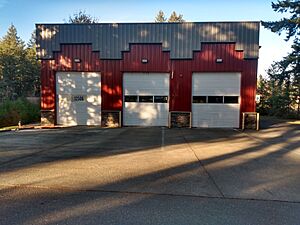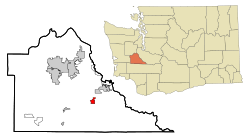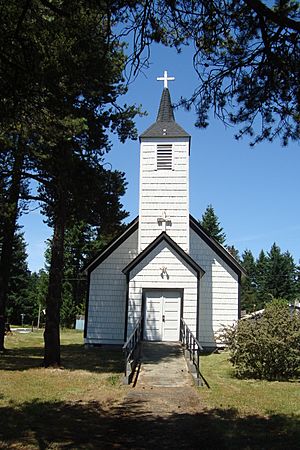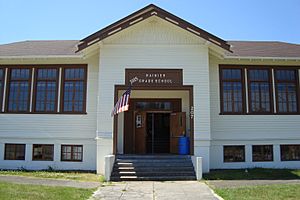Rainier, Washington facts for kids
Quick facts for kids
Rainier, Washington
|
|
|---|---|

Rainier Fire Station
|
|

Location of Rainier, Washington
|
|
| Country | United States |
| State | Washington |
| County | Thurston |
| Area | |
| • Total | 1.74 sq mi (4.50 km2) |
| • Land | 1.74 sq mi (4.50 km2) |
| • Water | 0.00 sq mi (0.00 km2) |
| Elevation | 433 ft (132 m) |
| Population
(2020)
|
|
| • Total | 2,369 |
| • Estimate
(2021)
|
2,486 |
| • Density | 1,315.88/sq mi (508.01/km2) |
| Time zone | UTC-8 (PST) |
| • Summer (DST) | UTC-7 (PDT) |
| ZIP code |
98576
|
| Area code | 360 |
| FIPS code | 53-57220 |
| GNIS feature ID | 1507707 |
Rainier (pronounced ray-NEER) is a city in Thurston County, Washington, United States. It started as a train stop in the 1870s. People first settled here in 1890. The city became well-known for its logging industry. Rainier officially became a city in 1947.
Contents
History of Rainier
Rainier began in the 1870s as a stop for trains. It was on the Northern Pacific Railroad line. This line connected Kalama, Washington and Tacoma. The area was called 'ten al quelth' by the Lushootseed people. This means "the best yet." The town was named Rainier because of its view of Mount Rainier.
In 1890, Albert and Maria Gehrke were the first people to build a home here. They used the Homestead Act to claim land. Later that year, Henry Harmer opened a store and a post office. He and his family also settled near the Deschutes River. Rainier was officially mapped out in 1891.
In 1896, the community got its first full-time school. Albert Gehrke and his brothers, Theodore and Paul, also built a Lutheran church. These buildings are now important historical sites in the state.
Logging and Fires in Rainier
In 1906, the Bob White Lumber Company opened. This brought a lot of business to the area. Logging and sawmills made the town grow. Other lumber companies, like Deschutes and Fir Tree, also came to Rainier.
In the late 1920s and early 1930s, many mills and buildings burned down. A series of fires destroyed them. Many people had to find work elsewhere. They went to Weyerhaeuser Lumber in nearby Vail. Vail is now a ghost town.
In 1936, Rainier's third school building was built. It was made of brick. This new school allowed an older part of the 1915 school to be removed. The 1915 school became a single-story building again.
Rainier's Growth and Changes
In 1940, Rainier had 500 people. In 1941, a guide described Rainier as a social center. It was for farmers and loggers. But it also noted the closed mills and empty houses. It called Rainier a "ghost lumber town."
Rainier officially became a city on October 23, 1947. In 1948, the town hall opened. It housed the city council, police, and fire departments.
On May 4, 1974, Rainier High School caught fire. An electrical problem in the attic caused it. The state's fire department had warned about fire risks before. Classes were stopped for the rest of the school year.
Local people and soldiers from Fort Lewis helped. They built 13 portable classrooms. These were placed next to the burned school. Seattle Public Schools sold the portable buildings cheaply. A new high school and elementary school opened on September 1, 1976.
In 1990, Rainier's current Town Hall was built. It was made from several parts put together. This building still serves as the Town Hall today.
Rainier's Geography
Rainier covers about 1.73 square miles (4.50 square kilometers) of land. There is no water area within the city limits. About 18% of the city is urban, meaning it has buildings and roads. Forests cover about 27% of the land. The remaining 55% has other plants and soil.
Rainier's Climate
The weather in Rainier is usually mild. The highest temperature ever recorded was 104°F (40°C) in 1981. But the average temperature in August, the hottest month, is 76°F (24°C). The lowest temperature recorded was -8°F (-22°C) in 1979. The average temperature in January, the coldest month, is 32°F (0°C).
November is the wettest month, with about 8.13 inches (20.7 cm) of rain. Rainier gets about 50 inches (127 cm) of rain each year on average.
Rainier's Population
| Historical population | |||
|---|---|---|---|
| Census | Pop. | %± | |
| 1950 | 331 | — | |
| 1960 | 245 | −26.0% | |
| 1970 | 382 | 55.9% | |
| 1980 | 891 | 133.2% | |
| 1990 | 991 | 11.2% | |
| 2000 | 1,492 | 50.6% | |
| 2010 | 1,794 | 20.2% | |
| 2020 | 2,369 | 32.1% | |
| 2021 (est.) | 2,486 | 38.6% | |
| U.S. Decennial Census 2020 Census |
|||
Population in 2020
In 2020, Rainier had 2,369 people. They lived in 871 homes. The average household income was $76,016. About 14.3% of adults had a college degree or higher education.
The average age in Rainier was 38.4 years old. About 27.4% of the people were under 18. The rest, 72.6%, were 18 or older. Most residents identified as White. There were also people identifying as Asian, Black, Native American, Pacific Islander, and people of two or more races. About 192 people identified as Hispanic or Latino.
Population in 2010
In 2010, Rainier had 1,794 people. There were 656 households and 484 families. The population density was about 1037 people per square mile. Most residents were White (90.7%). Other groups included African American, Native American, and Asian people. About 5% of the population was Hispanic or Latino.
The average age in the city was 37.1 years. About 26.1% of residents were under 18. The population was almost evenly split between males (49.7%) and females (50.3%).
Arts and Culture in Rainier
Public Art
Near downtown Rainier, there is a special mural. It is on a bridge support over Washington State Route 507. This mural is called the Sgt. Justin Norton Memorial Mural. Justin Norton was a graduate of Rainier High School. He died in 2006 during the Iraq War. The mural was put up in 2011. It has been repaired and repainted many times due to damage.
Festivals and Events
Rainier hosts several fun events every year. In August, there are two main events. The Rainier Roundup Days includes a community parade. It also has a bluegrass music festival. The Rainier Community & Alumni Celebration honors everyone from Rainier, past and present.
The community also regularly hosts Relay for Life. During this event, people walk around the high school track. They walk for 18 hours to raise money for the American Cancer Society.
Historic Buildings and Sites
In the early 2000s, the Rainier Historical Society started a project. They began to restore Rainier's historic schoolhouse. This building was built in 1915. They wanted to turn it into a community center. It is now known as the Lifelong Learning Center.
In 2005, the Rainier Food Bank opened there. It helped people get food on Wednesdays and Saturdays. A thrift store also opened. The money from the thrift store helped pay for the building's costs. An art gallery and meeting rooms were also added.
In November 2009, the Rainier Volunteer Library opened. It had many donated books for people to borrow. The library partnered with the Timberland Regional Library. This allowed people to pick up reserved books from the Timberland system.
In 2011, the food bank moved to a nearby church. This was due to safety concerns at the old schoolhouse. The historic school building was almost torn down. But in 2015, its 100th year, it was given back to the school district for offices. The library and thrift store then closed.
Parks and Recreation in Rainier
Rainier has eight acres of parks. In the middle of town is the Veterans Memorial Park. This park honors veterans and active military members. It also recognizes fire and police departments. Many volunteers and charity groups are honored here too.
Nearby is Wilkowski Park. This park hosts the Rainier Roundup. It is the city's yearly bluegrass music festival. It happens on the fourth weekend in August. Next to the park is the Yelm–Rainier–Tenino Trail. This paved path connects the cities of Yelm, Rainier, and Tenino. It is great for walking and biking.
Other parks in Rainier include Gehrke Park, Holiday Park, and Raintree Park.
Education in Rainier
Rainier is served by the Rainier School District. This district has an elementary school, a middle school, and Rainier High School. In the 2021–2022 school year, 925 students were enrolled. They were taught by 56 teachers.
Rainier Elementary School served 463 students. These students were in kindergarten through fifth grade. Rainier Middle School had 215 students in sixth through eighth grade. John Beckman was the principal in 2017. Rainier High School had 247 students. They were in ninth through twelfth grade during the 2021–2022 school year.
Notable People from Rainier
- Linda Evans, a television actress
- Chad Forcier, a two-time NBA champion assistant coach
- Eloy Pérez, a boxing champion (WBO and NABO super featherweight)
- Billie Rogers, a jazz trumpeter and singer
See also
 In Spanish: Rainier (Washington) para niños
In Spanish: Rainier (Washington) para niños





